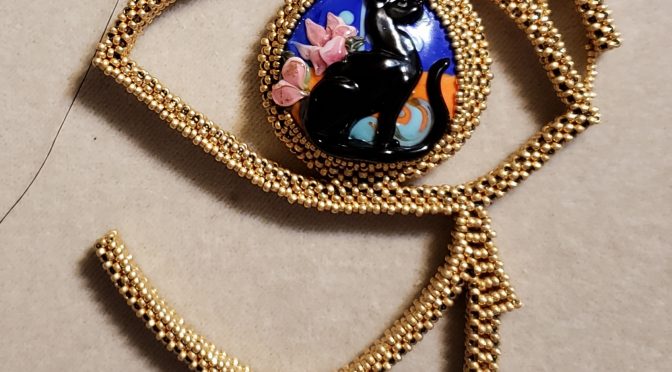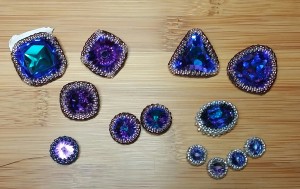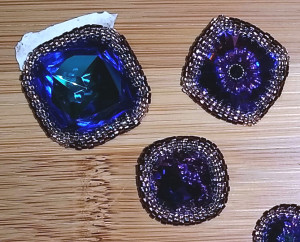Some designs are the culmination of many different desires: to make something beautiful out of someone else’s beautiful work; to challenge myself technically; to make use of knowledge I’ve collected over the years; to commemorate a friend. Sun God’s Eye is that sort of jewelry.
I’m fascinated by lampwork beads. Glass can take so many different shapes, colors, textures, and effects. Amongst the many glass artists I admire on Etsy, I’m captivated by the work of Rebecca Jurgens at LandS Arts. She creates vivid animal portraits in her glass beads (as well as fine art paintings and intricate sterling “multi-media” pendants). In my hunt for interesting black cats to use as focal pieces for necklaces and bracelets, I discovered one of Rebecca’s cats:

When finances allowed — and before she stopped accepting custom commissions! — I asked her to make me an Egyptian Squib.

As soon as I saw it, I wanted to somehow make it the center of an Egyptian Eye of Ra. I spent a month honing my use of a technique called cubic right angle weave, which lends itself to the geometric flavor of Egyptian art. But the bead is large. Adding a hieroglyphic frame around it left me with a pendant that’s about 4″ square. Not everyday wear.

My success with the Eye of Ra convinced me that I was finally ready to tackle a long-standing goal: creating a piece of seed bead jewelry to enter in Bead & Button Magazine’s annual competition, Bead Dreams.
I’ve watched the Bead Dreams finalists and winners avidly for years, and wanted to create something competitive for about that long. The 2019 competition became my excuse for taking everything I know about ancient Egyptian art symbolism — and jewelry — and turning it into something wearable. My intention is to produce an Egyptian broad collar — what you probably think of when you hear the phrase “ancient Egyptian jewelry” — that combines the meanings of colors and shapes from Egyptian art, and the symbolism of Egyptian religion, with modern bead weaving techniques and design aesthetics. The idea is that an ancient Egyptian would recognize my design as a wesekh collar, freighted with religious meaning, but I could wear it with a dress and not looked like I robbed a museum.
My goal for Bead Dreams is humble: I’ll be delighted if I make it past the jury. The initial submission consists of up to 5 photographs, submitted over the web, no later than April 8, 2019.
Because the Eye of Ra, built around Rebecca’s lovely Egyptian Squib bead, is the centerpiece of my collar, I’ve named the project Sun God’s Eye. The Egyptian cat goddess, Bast or Bastet, is frequently portrayed as a black cat, and is referred to in Egyptian religion as the Eye of Ra herself:
Bastet, the Great One, the Lady of Bubastis, the Eye of Ra, who is in Behedet, who sits on the throne, who smites the enemies, who is protected by the gods. [From “Goddess on the Water: the Sacred Landscape of Bubastis” by Eva Lange-Athinodorou & Tobias Ullmann, in Egyptian Archaeology, vol 47:17-19 (January 2015) — the line is part of a hymn transcribed at the temple of Hathor at Edfu.]]




